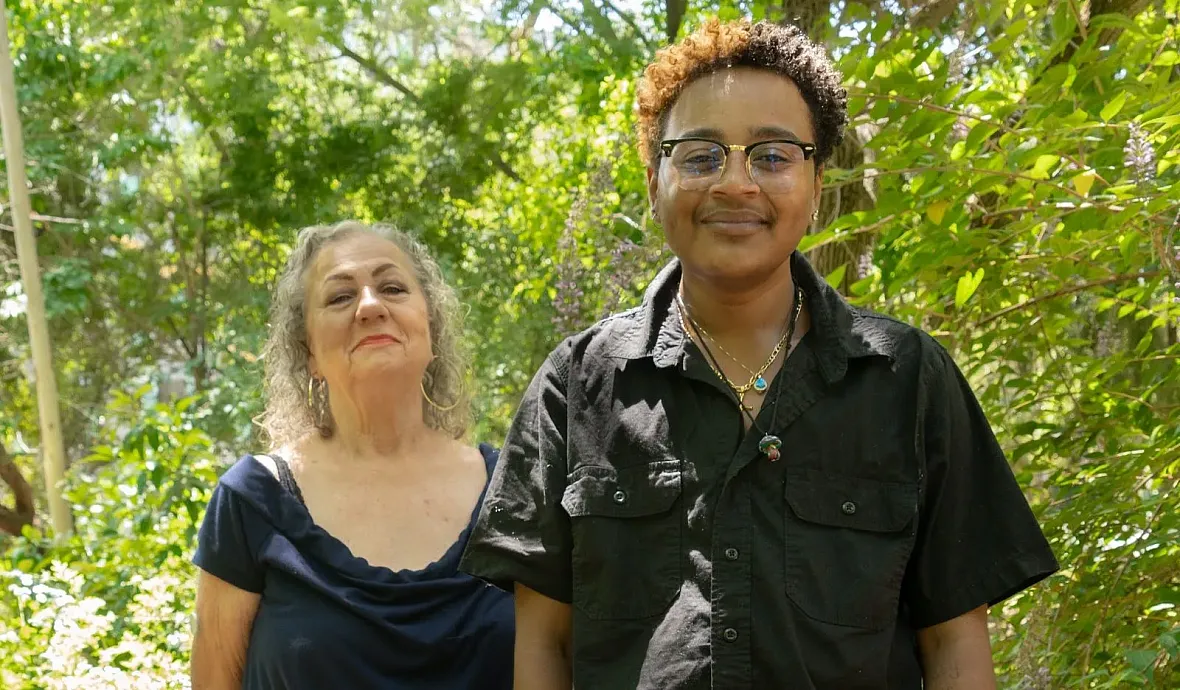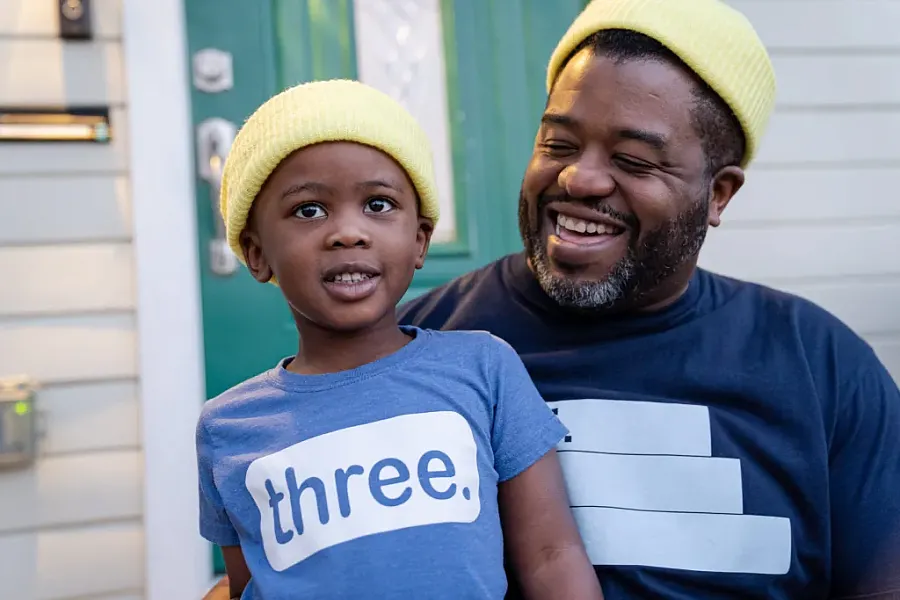Experts Urge More Support For Kin Care For Black Children In Foster System
The story was originally published by The Observer with support from our 2025 Child Welfare Impact Reporting Fund

Malachi Chaney-McClain says he owes a great deal to his grandmother, Mary Chaney, who adopted him and his siblings.
Roberta Alvarado, OBSERVER
At the age of 121/2, Malachi Chaney-McClain moved in with his beloved grandmother, Mary. Before that, his life was marked by chaos and uncertainty.
Over time, Chaney-McClain learned to understand more about his parents’ mental health challenges and their substance use struggles. He’s navigated a few of his own as well.
“She never gave up on me,” Chaney-McClain says of the woman he calls the family’s “foundation.”
“It takes a village and my Nana put a lot of time and effort into making sure that I had what I needed.”
In Nana’s home there was warmth and a sense of permanence. Mary Chaney, who is white, formally adopted her mixed race grandchildren, wanting to prevent further disruption by their biological parents.
“I entered safe hands and I just never left them,” says Chaney-McClain, now 24.
Today, Chaney-McClain participates in the Guardian Scholars Program at Sacramento State and is an active volunteer with the California Youth Commission, often sharing his experiences to advocate for foster youths’ rights. To now be invited into spaces where change is happening has been a priceless experience, a path that his grandmother put him on.
“I don’t think I will ever be truly content and proud of myself until I know my Nana is proud of me,” Chaney-McClain says.
“I need her to see that her hard work wasn’t in vain. I need her to know that I am going to get that job, I am going to finish school, I’m going to have a partner. One day, I’m going to have children, possibly. I need her to know that this cycle that kept happening is done.”
RELATED: Black Advocates Fight For Justice In Foster Care
Not everyone who signs up to be foster parents should be, Chaney-McClain adds. While most genuinely want to help, many take in other people’s children “just for a check” and don’t give much effort to actually caring for them beyond the basic requirements.
“There are different ways of fostering, and no one way is perfect,” he says. “But I think it’s very hard for a lot of people to come to terms with ‘This is someone else’s child, but I should treat them with the same care as mine.’”
Over the years, Chaney-McClain and his siblings experienced instability alongside their parents, including bouts of homelessness and shuffling between family and friends. They also were sent to live with people they didn’t know. Chaney-McClain never felt comfortable in those Child Protective Services-approved arrangements.
“It was such a weird way of living,” he says. “It’s like I had a tag on my shirt that just wouldn’t come off. Once I got home with Nana, there was no tag.”
Nana’s house is not something that I ever wanted to run away from. I definitely struggled with mental illness and I had a lot of challenges, but she created a space for me where I could make a mistake and not be ridiculed or punished. I learned that even if I did make a mistake, no one was gonna come and get me or take me away
Malachi Chaney-McClain
‘Support’ Systems

Kinship care worked for Malachi Chaney-McClain, left, after years of instability and being involved in the foster care system. Now, 24, Chaney-McClain works to help establish rights for others impacted by the system.
Roberta Alvarado, OBSERVER
County data shows a reduction in Sacramento’s overall foster care population by 26.5% over the last five years. Notably, there has been a 31.5% reduction in Black children in foster care in that period. In 2020, there were 422 Black children ages 0-17 in care, compared to 289 in February 2025. County officials credit a recommitment to keeping families intact. Challenges persist however, in improving reentry rates into the system and ensuring stable placement options for children.
“We are very much a kin-first agency,” says Kim Pearson, a division manager in the county’s Department of Child, Family, and Adult Services. “We want to see kids placed with their families. Youth have a better opportunity at reunifying if they are placed with family.”
Local social worker LiMetrias Daniels, who has been with Sacramento County CPS for nearly four years, says she doesn’t typically remove children from their parents.
“I tend to leave them at home and if it’s not at home, it’s with their families because I don’t want to disrupt the family, because that’s more harm for the children,” Daniels says.
Many of those on her caseload are babies born with drugs in their systems.
RELATED: County, Local Initiatives Address Black Imbalance In Sac Child Welfare System
“If I have to remove, it’s going to be a baby, somebody, who has been physically abused, and we know that [the abuse] was at the hands of one of their parents, and there’s evidence, those children automatically are going to be removed, but most of the time, I’m trying to just give them resources and try to keep the family unit together.”
Daniels often makes referrals through the Black Child Legacy Campaign, which connects parents to needed resources such as counseling, housing and employment help. She recently met with a Black father who kicked his 17-year-old son out of the house for allegedly stealing money from him. After visiting the man, interviewing the teen at his school and visiting the temporary group home he’d been staying at, it was determined the boy would move in with a cousin.
“Kinship care is one of the many examples of improvement in child welfare,” child welfare expert Rob Green says.
“Think back to the 1990s when there was a crack academic. We had an unprecedented number of kids in foster care and we fell into kinship care out of necessity,” continues Green, founder of the national consulting firm CWPolicy LLC. “We couldn’t find any place to put kids, so we said, ‘Let’s try relatives.’ There was, at that point, a persistent belief and fear that we should not trust relatives of ‘abusive’ parents. We haven’t entirely lost that ‘apple doesn’t fall far from the tree’ mentality, but we’ve come a long way.
“Kinship care is the preferred placement in every state. We are increasing our rates and use of kinship care. We have requirements for when a child comes into care to notify and to find a child’s relatives before considering a nonrelative placement. We have relatively new rules for allowing states to develop specific licensing criteria to try to get around some of the financial barriers and yet, I still have lots of concerns.”
State benefits from the Chaney-McClain children ended when they were formally adopted.
“My Nana used her retirement to support us,” Malachi says. “She worked for the state and retired with the state.”
The system isn’t effectively supporting families with the children it places with them, Green says.
“We have this assumption that just because they’re with a relative, ‘they’ll be fine,’ that we don’t need to support them in the way we would another family,” he continues. “That’s just not accurate in many states, and in more than 20 states we continue to use unlicensed kinship care for a child who’s in state custody, and yet we can’t license you, and without the licensing, you’re not getting the same level of payment and resources. I want someone to explain the legitimacy of that because I still do not understand.”
Bryan Samuels, executive director of Chapin Hall, a University of Chicago child welfare think tank, says strong evidence suggests that providing intensive and appropriate family services can prevent getting involved in the system in the first place.
“That doesn’t mean that child welfare can get it right every time,” Samuels says. “These are really complicated cases and have a limited amount of time to investigate and make a determination, and so no child welfare system is perfect in that respect.
“But if you’re going to play the odds, you probably have better odds keeping families together and putting in place intensive interventions than you do taking kids away from their families and then trying to figure out how to piece that family back together again after they’ve had a quite traumatic experience.”
Family ’First’

Dr. Angelo Williams pictured with his nephew.
Louis Bryant III, OBSERVER
A decade before his son entered the world, local professor Dr. Angelo A. Williams became a father.
The local professor opened his heart and his home to his sister’s three children upon her untimely passing in 2013.
“Angelique was an amazing human being,” Dr. Williams says. “Even before she had kids, she said, ‘If anything ever happens to me, I need you to take my kids.’”
He responded with a resounding yes, willing, but never actually expecting to fulfill the promise.
African Americans have historically stepped up, taking in children from their extended families whenever possible. Some go through the system and others are more informal situations. Parental absences created by the prevalence of drugs, overpolicing and mass incarceration in the Black community have also flooded the child welfare system. It is not uncommon for grandparents and even great-grandparents to take on the raising of children, despite limited incomes and declining health.
RELATED: Experts Say Child Welfare System Reform Needed To Better Serve Black Children
In addition to being personally connected, Dr. Williams championed kinship care professionally in his previous role as chief deputy director of First 5 California, a position he recently was forced to vacate due to the state’s budget woes. First 5 offers a number of resources for relative caregivers, including in-home support, counseling and other services through a partnership with the Kinship Support Services Program.
Dr. Williams typically rejects praise and accolades for doing what he has been told “many others wouldn’t have.”
“I didn’t do any of this by myself,” he says. “My mother helped. When I got married, my wife helped. Friends helped. All these kids had side mentors and ‘play’ aunties and uncles. This community raised these kids and they’re all doing great.”
All three graduated from college and now work in early childhood education, tech, or are contemplating graduate school.
“I feel extremely blessed that I had a mom who stepped in with me, right? An auntie who stepped in with me, my grandmother who stepped in with me,” Dr. Williams says, pointing to his Southern roots. “They surrounded me. They covered me. While I was covering the kids, they covered me.
“That’s Black family and that’s just how it’s always been.”

